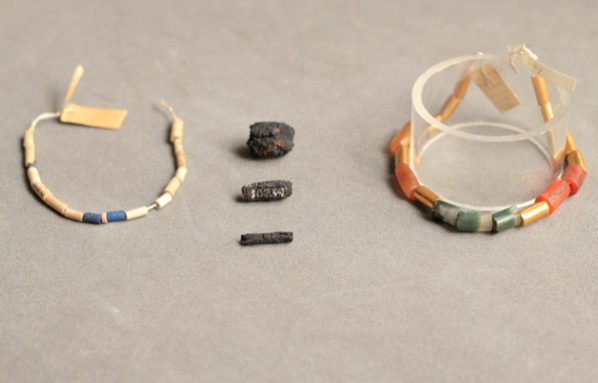Ancient jewelry from space
Egyptians used metal from meteorites to make jewelry more than 5,000 years ago

Jewelry in Ancient Egypt wasn’t just fancy: Some of it was out of this world!
That’s the conclusion of two groups of scientists studying iron beads from an ancient Egyptian necklace. They found that those beads were made out of metal mined from meteorites. And that creation was no easy feat: The alien iron first had to be heated and hammered into thin sheets, then rolled into cylindrical beads.
People in what is now Turkey began to make similar beads from soft metals like copper and gold about 9,000 years ago. To do the same thing with chunks of iron would have proved far more challenging, Thilo Rehren told Science News. Rehren, who led one of the new studies, works in the Middle East at a University College London campus in Doha, Qatar. As an archaeometallurgist (AR-kee-oh-MEH-tah-lur-gizt), he studies how ancient cultures worked with metals.
The ancient Egyptians heated, hammered and flattened a meteorite’s iron about 5,200 years ago. They didn’t start using the same technique on iron ore — iron extracted from Earthly rocks — until the Iron Age, some 2,000 years later. Egyptian blacksmiths appear to have honed their skills on meteorite iron before applying the technique to ore mined from Earth.
The discolored and damaged beads were discovered a century ago. Rehren’s team recently probed the beads’ internal structure with X-rays and other types of imaging. They found that the crystal structure of the iron had broken down. Intense heating and hammering had caused the damage, they reported August 20 in the Journal of Archaeological Science.
The beads’ metal also contained other elements. These included the cobalt and nickel often found in meteorites.
Another team of scientists disagreed with some conclusions of Rehren’s team. Planetary scientist Diane Johnson of the Open University in Milton Keynes, England, worked on the second study. Her group argued that heating did not cause the damage seen in the iron beads. They propose instead that chemicals applied by museum employees to preserve the beads caused some of the corrosion. Supporting that view: One bead in the necklace still looked undamaged. Unlike the others, it had not been treated with chemicals.
Johnson’s team published its findings in the June issue of Meteoritics & Planetary Science.
No matter how the Egyptians fashioned their beads, notes Timothy McCoy, both studies show that the pre-Iron Age culture used iron from meteorites for jewelry. McCoy is a geologist at the Smithsonian Institution in Washington, D.C. What remains unknown, he told Science News, is where the material was found, or what tools were used to fashion it into finery.
Power Words
archaeometallurgy The study of how ancient cultures worked with metal.
archeology The study of human history and prehistory through the excavation of sites and the analysis of artifacts and other physical remains.
geology The study of Earth’s physical structure and substance, its history and the processes that act on it. Planetary geology is the science of studying the same things about other planets.
metallurgy The study of metals, their properties and production.







